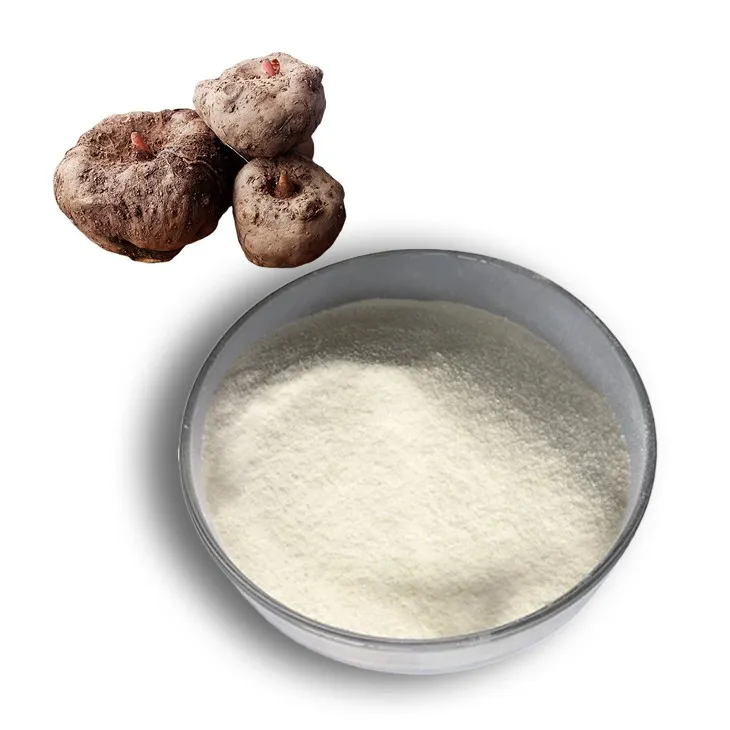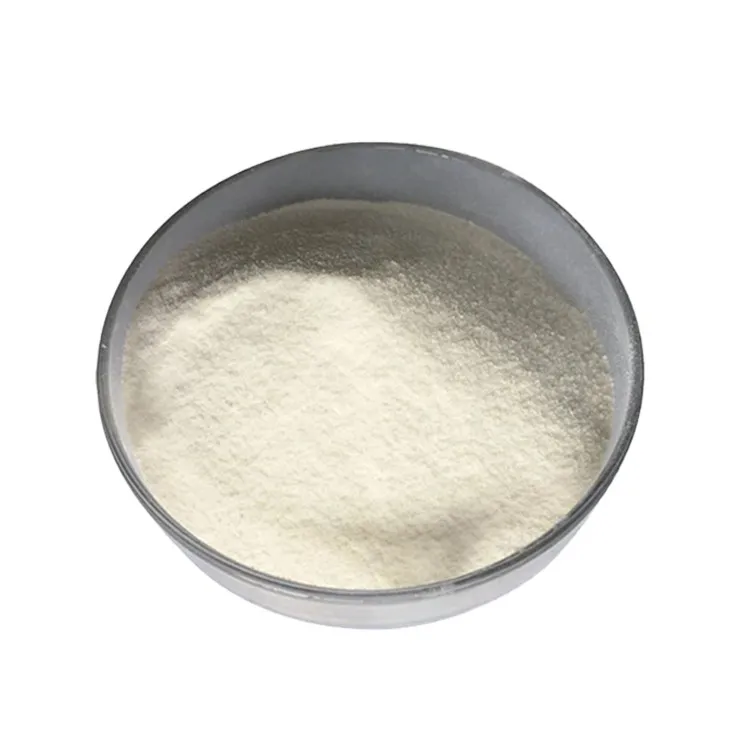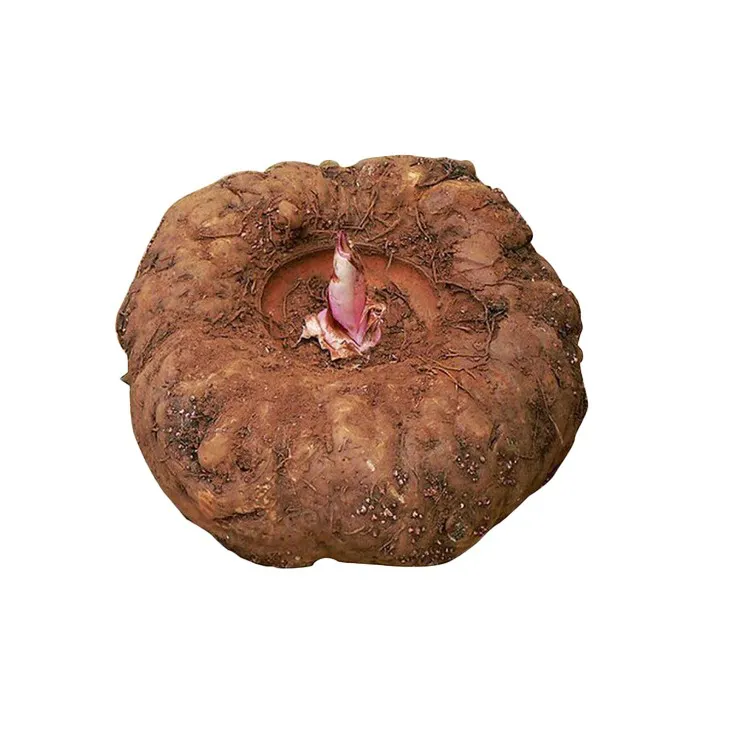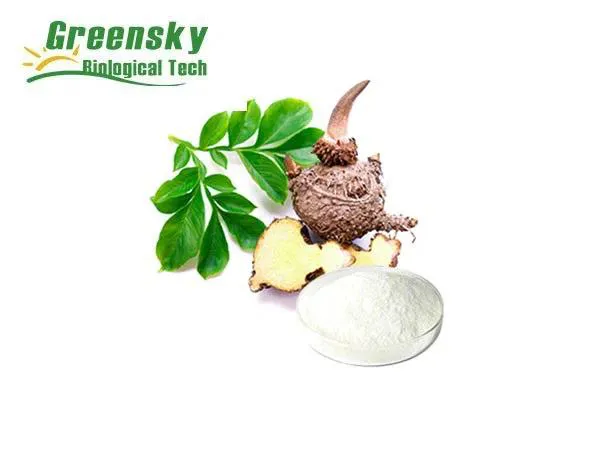- 0086-571-85302990
- sales@greenskybio.com
Konjac powder can reduce high blood pressure.
2024-11-13

1. Introduction
High blood pressure, also known as hypertension, is a common and serious health condition that affects millions of people worldwide. It is a major risk factor for heart disease, stroke, and other cardiovascular problems. While there are various medications available to treat hypertension, many people are also interested in natural remedies that can help manage their blood pressure. Konjac flour, which is made from the konjac plant, has emerged as a potential natural aid for reducing high blood pressure.

2. The Konjac Plant and Konjac Flour
The konjac plant, scientifically known as Amorphophallus konjac, is native to Asia. It has a large, starchy corm that is used to produce konjac flour. Konjac flour is rich in dietary fiber, particularly glucomannan, which is a type of soluble fiber. Glucomannan has unique properties that make it beneficial for health, including its potential role in blood pressure management.

3. Mechanisms of Action for Lowering Blood Pressure
3.1 Dietary Fiber Content
The high dietary fiber content in konjac flour, especially glucomannan, plays a significant role in reducing high blood pressure. Soluble fiber like glucomannan forms a gel - like substance in the digestive tract. This gel slows down the absorption of carbohydrates, which in turn helps to regulate blood sugar levels. Stable blood sugar levels are associated with better blood pressure control. When blood sugar spikes are minimized, it reduces the stress on the body's hormonal and metabolic systems that can otherwise contribute to elevated blood pressure.
Moreover, the fiber in konjac flour promotes satiety, which can lead to better weight management. Excess weight is a well - known risk factor for high blood pressure. By helping people feel full with fewer calories, konjac flour can assist in weight loss or weight maintenance, thereby indirectly reducing blood pressure.
3.2 Effects on Blood Lipid Regulation
Konjac flour also has an impact on blood lipid regulation, which is closely related to blood pressure. Glucomannan has been shown to lower levels of low - density lipoprotein (LDL) cholesterol, also known as "bad" cholesterol. High levels of LDL cholesterol can lead to the build - up of plaque in the arteries, causing them to narrow and increasing blood pressure. By reducing LDL cholesterol, konjac flour helps to keep the arteries clean and flexible, allowing for normal blood flow and lower blood pressure.
Additionally, konjac flour may also increase levels of high - density lipoprotein (HDL) cholesterol, or "good" cholesterol. HDL cholesterol helps to remove excess cholesterol from the bloodstream and transport it back to the liver for processing. This further contributes to the overall improvement of cardiovascular health and blood pressure regulation.

4. Incorporating Konjac Flour into a Healthy Diet for High Blood Pressure
4.1 Konjac Noodles
One of the most popular ways to consume konjac flour is in the form of konjac noodles. Konjac noodles are very low in calories and carbohydrates compared to traditional wheat - based noodles. They can be used in a variety of dishes, such as stir - fries or soups. For example, you can make a simple stir - fry by combining konjac noodles with vegetables like broccoli, carrots, and mushrooms, and adding a small amount of lean protein such as chicken or tofu. This makes for a healthy, low - calorie meal that is suitable for those with high blood pressure.
4.2 Konjac Jelly
Konjac jelly is another option. It can be made at home or purchased pre - made. Konjac jelly can be a refreshing and low - calorie snack. You can add fruits like berries or sliced apples to the konjac jelly to make it more nutritious and flavorful. However, it is important to be cautious when purchasing pre - made konjac jelly products as some may contain added sugars or other additives that are not beneficial for blood pressure control. Reading the labels carefully is essential.
4.3 Baking with Konjac Flour
Konjac flour can also be used in baking, although it has different properties compared to traditional flours. It can be combined with other gluten - free flours such as almond flour or coconut flour to make baked goods like muffins or bread. When using konjac flour in baking, it is important to note that it may absorb more liquid than regular flours, so adjustments to the recipe may be necessary. Baked goods made with konjac flour can be a part of a healthy diet for those with high blood pressure as long as they are consumed in moderation and as part of an overall balanced diet.

5. Precautions and Considerations
While konjac flour can be a beneficial addition to the diet for those with high blood pressure, there are some precautions to keep in mind. Firstly, konjac flour has a high fiber content, and if introduced into the diet too quickly, it can cause digestive discomfort such as bloating, gas, or diarrhea. It is recommended to start with small amounts and gradually increase the intake over time to allow the body to adjust.
Secondly, some people may be allergic to konjac. Allergic reactions can range from mild symptoms like itching or hives to more severe reactions such as difficulty breathing or anaphylaxis. If you have a history of food allergies or are unsure if you are allergic to konjac, it is advisable to consult a doctor before consuming konjac - based products.
Finally, konjac flour should not be used as a substitute for medical treatment for high blood pressure. While it can be a helpful adjunct in managing blood pressure, those with hypertension should continue to follow their doctor's advice regarding medications and lifestyle changes.

6. Conclusion
In conclusion, konjac flour shows promise as a natural aid for reducing high blood pressure. Its mechanisms of action, including its high dietary fiber content and effects on blood lipid regulation, make it a potentially valuable addition to the diet of those with hypertension. By incorporating konjac flour into a healthy diet in the form of konjac noodles, jelly, or baked goods, individuals can potentially benefit from its blood - pressure - lowering properties. However, it is important to take precautions when consuming konjac flour, and it should not replace medical treatment. With proper use and in combination with other lifestyle changes and medical management, konjac flour can be part of a comprehensive approach to managing high blood pressure.
FAQ:
Question 1: How does konjac flour reduce high blood pressure?
Konjac flour may reduce high blood pressure through several mechanisms. Firstly, its high dietary fiber content can help regulate the body's functions. Dietary fiber can promote proper digestion and absorption, which may in turn have a positive impact on blood pressure regulation. Secondly, konjac flour may also play a role in blood lipid regulation. By helping to keep blood lipids at a healthy level, it can contribute to overall cardiovascular health and potentially lead to a reduction in high blood pressure.
Question 2: What is the recommended amount of konjac flour for high - blood - pressure patients?
The exact recommended amount of konjac flour for high - blood - pressure patients may vary depending on individual factors such as overall health, diet, and other medical conditions. However, generally, it should be consumed in moderation as part of a balanced diet. It is advisable to start with a small amount, for example, about 5 - 10 grams per day, and gradually increase the amount while observing how the body responds. It is also important to consult a doctor or a nutritionist for personalized advice.
Question 3: Can konjac flour be a substitute for blood pressure medications?
No, konjac flour cannot be a substitute for blood pressure medications. While konjac flour may have potential benefits in reducing high blood pressure, it is not a replacement for medical treatment. High blood pressure is a serious medical condition that often requires the use of medications prescribed by a doctor. Konjac flour can be used as a complementary addition to a treatment plan that includes proper medical care, diet, and lifestyle changes.
Question 4: Are there any side effects of consuming konjac flour for high - blood - pressure patients?
Some possible side effects of consuming konjac flour may include gastrointestinal discomfort such as bloating, gas, or diarrhea, especially if consumed in large amounts too quickly. However, these side effects are relatively rare and can often be avoided by gradually introducing konjac flour into the diet. High - blood - pressure patients should also be aware of any potential interactions with other medications or medical conditions they may have, and it is always best to consult a doctor before making significant changes to their diet.
Question 5: How can konjac flour be incorporated into a diet for high - blood - pressure patients?
Konjac flour can be incorporated into a diet for high - blood - pressure patients in various ways. It can be used to make konjac noodles, which can be a low - calorie and fiber - rich alternative to regular pasta. Konjac flour can also be added to soups or stews to thicken them while adding nutritional value. Another option is to use it in baking, although this may require some experimentation as it has different properties compared to traditional flours. Additionally, konjac - based products like konjac jelly can be consumed as a healthy snack option.
Related literature
- Title: The Role of Konjac in Hypertension Management"
- Title: "Konjac Flour and Cardiovascular Health: New Insights"
- Title: "Dietary Konjac for Blood Pressure Regulation: A Review"
- ▶ Hesperidin
- ▶ citrus bioflavonoids
- ▶ plant extract
- ▶ lycopene
- ▶ Diosmin
- ▶ Grape seed extract
- ▶ Sea buckthorn Juice Powder
- ▶ Beetroot powder
- ▶ Hops Extract
- ▶ Artichoke Extract
- ▶ Reishi mushroom extract
- ▶ Astaxanthin
- ▶ Green Tea Extract
- ▶ Curcumin Extract
- ▶ Horse Chestnut Extract
- ▶ Other Problems
- ▶ Boswellia Serrata Extract
- ▶ Resveratrol Extract
- ▶ Marigold Extract
- ▶ Grape Leaf Extract
- ▶ blog3
- ▶ blog4
- ▶ blog5
-
Organic Tongkat Ali extract powder factory.
2024-11-13
-
How to make powder with ashwagandha extract.
2024-11-13
-
Rosehip extract manufacturers from China.
2024-11-13
-
The best cat's claw extract in nature.
2024-11-13
-
Chinese Dandelion Leaf Extract Suppliers.
2024-11-13
-
Boswellia Serrata Extract
2024-11-13
-
Propolis Extract Powder
2024-11-13
-
Citrus Aurantium Extract
2024-11-13
-
Shikonin
2024-11-13
-
Grapefruit Seed Extract Powder
2024-11-13
-
Bilberry Extract
2024-11-13
-
Tamarind extract powder
2024-11-13
-
Diosmin
2024-11-13
-
Phyllanthus Emblica Extract
2024-11-13
-
Camu Camu Extract
2024-11-13





















